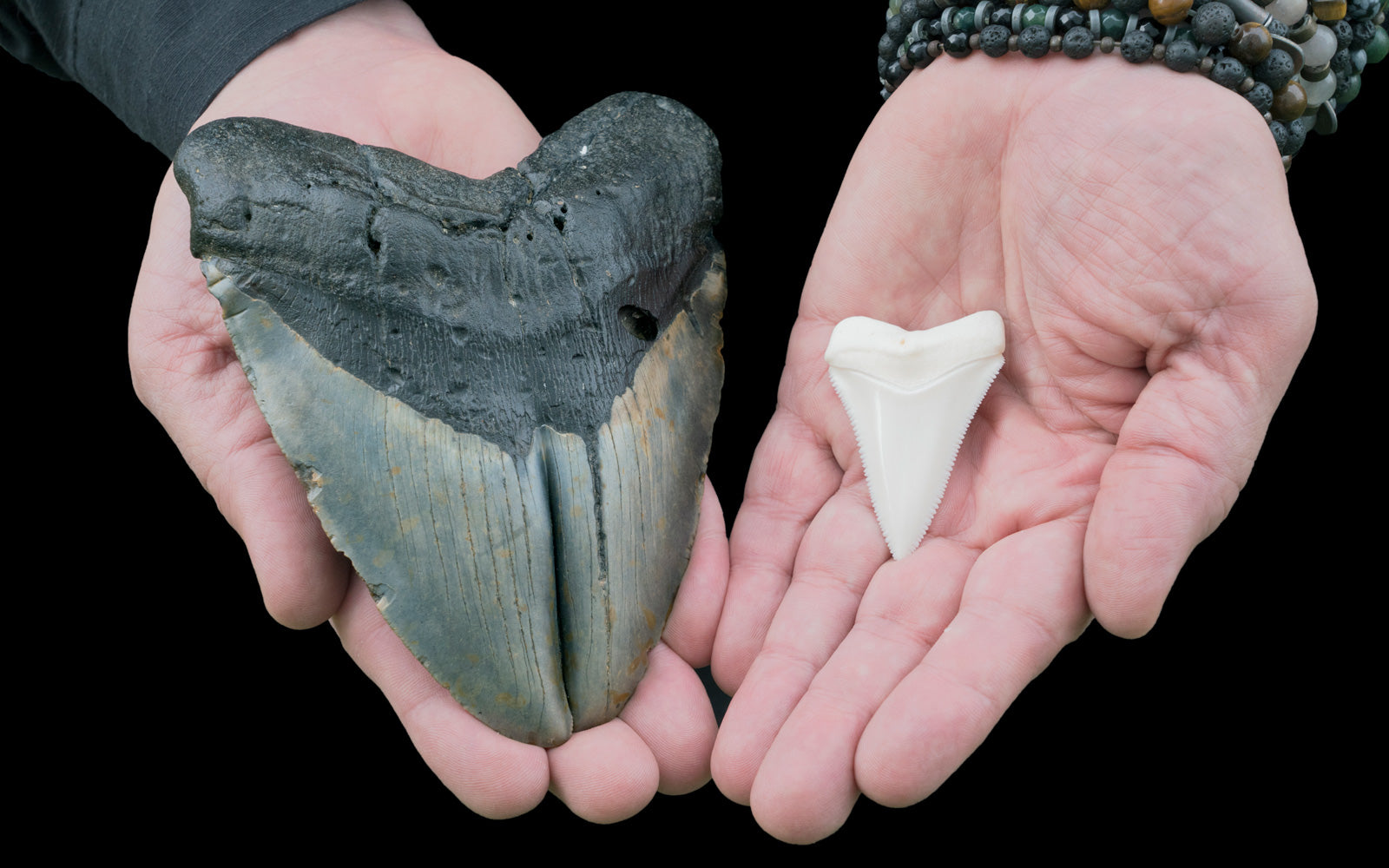
A Guide for Buying Megalodon Teeth
Even for the most experienced fossil collector, looking at and sifting through Megalodon teeth to purchase can be overwhelming. You probably have a lot of questions about the pricing of Megalodon teeth, and what you should spend.
The first step is to ask yourself why you are purchasing supersized shark teeth. Is it for your personal collection? Is it a gift? Who is the recipient? These questions are important because an experienced collector needs a better fossil at a higher price point than a child just beginning to explore fossils and shark teeth.
Regardless of whether you’re looking for yourself or a fellow fossil lover, Megalodon teeth are a great addition. After all, who doesn’t look in amazement at a giant Megalodon tooth? That huge tooth fit in the mouth of the biggest shark to ever live! Different than Great White Shark teeth, or any other tooth, when you purchase Megalodon teeth, you bring home a piece of ancient natural history.
How Are Megalodon Teeth Priced?
There are a variety of factors that go into the pricing of Megalodon teeth, including:
- Size - Megalodon teeth are measured diagonally, from the corner of the root to the tip of the tooth, using the longest side’s measurement. Typically, the larger the Megalodon tooth, the more it is worth. This increase in price is because as size increases, so does rarity. Megalodon teeth around two inches big are relatively common. Megalodon teeth over five inches are rare and sought after by collectors. Megalodon teeth over seven inches are the crown jewel of shark teeth, as they are extremely scarce and, as such, will cost you a very pretty penny.
- Location - The location from which a Megalodon tooth is found can impact pricing significantly. For example, if a location is deemed inaccessible for shark teeth collecting, the price of a tooth found in that area jumps significantly. Common places for the discovery of Megalodon teeth include rivers and oceans in the Carolinas, and discovery is less common in other places around the world. If located in an uncommon area, the Megalodon tooth will be more expensive. Locations from which shark teeth fossilize also affects the color of the tooth, as it has to do with the local sediment. The most common color is dark gray to black, so any other colors will increase the price point.
- Tooth Condition - As you would expect, the condition of the Megalodon tooth plays a factor in its pricing. A tooth with no flaws is very rare, and higher priced. Flaws can be, and typically are, plentiful and there are many to consider.
- Enamel - Larger teeth commonly have peeled enamel. The more intact enamel, the higher the price.
- Root - A piece of shark tooth that typically receives damage is the root portion. The more root, the higher the price.
- Serrations - Unlike Great White Shark teeth, Megalodon teeth have finer, more regular serration. How complete and sharp the serrations are is taken into pricing considerations.
- Tip - Megalodon teeth with sharp tips are extremely rare, and thus more expensive.
- Chipping - Chips out of the edge of the blade of the shark tooth affects pricing.
- Bourrelet - The bourrelet, a characteristic of Megalodon teeth, is a band of enamel located between the blade and the root of the tooth. The bourrelet typically receives damage, and an intact bourrelet is very rare.
- Restoration and Repair - If portions of shark teeth are glued together or reconstructed, it significantly lowers the tooth’s price. You should always know what you’re purchasing and find a reputable source, as some sellers are not honest about this factor of their shark teeth.
- Polishing - Most collectors consider a slightly buffed Megalodon tooth acceptable, however, a polished tooth is a no go. Polishing a shark tooth damages the tooth and could be potentially hiding significant flaws. It’s for these reasons that a highly polished Megalodon tooth is far less valuable.
Are Megalodon Teeth Rare?
As you’ve likely gathered from the list above, the answer to the rarity question of Megalodon teeth comes down to a variety of factors. Megalodons, like all shark species, frequently shed worn teeth through their lifetimes. For this reason, small Megalodon teeth are more common. The largest Megalodon tooth found is 7.48 inches, and that is extremely rare.
Megalodon teeth are sought after because they’re fossilized, and come from a giant animal that went extinct approximately 2.6 million years ago.
Where Can I Buy Megalodon Teeth?
There are many Megalodon teeth dealers all over the world, and today it’s easy to access them via the internet. The most important thing to consider when purchasing a Megalodon tooth, especially a rare and valuable one, is whether you can trust the seller. Unfortunately, many people are less than honest when it comes to shark teeth, and may try to sell teeth that are restored or not authentic. At Whaler’s Locker, we have a fantastic collection of Megalodon teeth paired with an excellent reputation and a guarantee of authenticity.
How Can I Be Sure That My Megalodon Tooth is Authentic?
Unfortunately, with the naked eye, it can be challenging to determine whether a Megalodon tooth has been restored or repaired. This is especially true if the work was completed by a professional. The easiest way to test for restoration to the tooth’s enamel is to use a UV or ultraviolet light. Untouched enamel will shine, while dark spots indicate repair. The glue used for repairs will shine under the light as well, making it visible.
There are other methods for testing the authenticity of your Megalodon tooth, like a hot needle or acetone. However, they could do severe damage to a restored or repaired tooth, so we don’t recommend it.
Whaler’s Locker is a Megalodon tooth retailer that you can trust. We offer a vast selection of teeth for every price point, and whether you are looking for a gift or for the perfect tooth to expand your collection, you’re sure to find it here.



